Padre Pio
Padre Pio, also known as Saint Pio of Pietrelcina (Italian: Pio da Pietrelcina), (25 May 1887 – 23 September 1968), was an Italian friar, priest, stigmatist and mystic,[1] now venerated as a saint in the Catholic Church. Born Francesco Forgione, he was given the name of Pius (Italian: Pio) when he joined the Order of Friars Minor Capuchin.
Padre Pio Saint Pio of Pietrelcina, O.F.M.Cap. | |
|---|---|
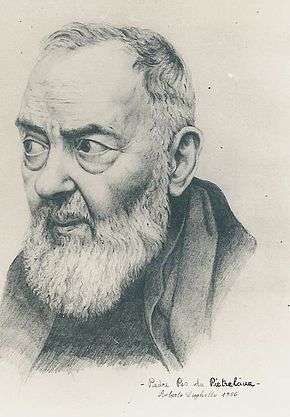 | |
| Priest, Religious, Mystic, Stigmatist, and Confessor | |
| Born | Francesco Forgione 25 May 1887 Pietrelcina, Benevento, Kingdom of Italy |
| Died | 23 September 1968 (aged 81) San Giovanni Rotondo, Foggia, Italy |
| Venerated in | Catholic Church |
| Beatified | 2 May 1999, Saint Peter's Square, Vatican City by Pope John Paul II |
| Canonized | 16 June 2002, Saint Peter's Square, Vatican City by Pope John Paul II |
| Major shrine | Sanctuary of Saint Pio of Pietrelcina, in San Giovanni Rotondo, Italy |
| Feast | 23 September |
| Attributes | Stigmata, Capuchin habit |
| Patronage | Pietrelcina, Italy; civil defense volunteers; adolescents; stress relief; January blues; Italy |
Padre Pio became famous for exhibiting stigmata for most of his life, thereby generating much interest and controversy. He was both beatified (1999) and canonized (2002) by Pope John Paul II.[2]
The Sanctuary of Saint Pio of Pietrelcina is located in San Giovanni Rotondo, Province of Foggia, Italy.
Life
Early life

Francesco Forgione was born to Grazio Mario Forgione (1860–1946) and Maria Giuseppa Di Nunzio (1859–1929) on May 25, 1887, in Pietrelcina, a town in the province of Benevento, in the Southern Italian region of Campania.[3] His parents were peasant farmers.[4] He was baptized in the nearby Santa Anna Chapel, which stands upon the walls of a castle.[5] He later served as an altar boy in this same chapel. He had an older brother, Michele, and three younger sisters, Felicita, Pellegrina, and Grazia (who was later to become a Bridgettine nun).[4] His parents had two other children who died in infancy.[3] When he was baptized, he was given the name Francesco. He stated that by the time he was five years old, he had already made the decision to dedicate his entire life to God.[3][5] He worked on the land up to the age of 10, looking after the small flock of sheep the family owned.
Pietrelcina was a town where feast days of saints were celebrated throughout the year, and the Forgione family was deeply religious. They attended Mass daily, prayed the Rosary nightly, and abstained from meat three days a week in honor of Our Lady of Mount Carmel.[5] Although Francesco's parents and grandparents were illiterate, they narrated Bible stories to their children.
According to the diary of Father Agostino da San Marco (who was later his spiritual director in San Marco in Lamis) the young Francesco was afflicted with a number of illnesses. At six he suffered from severe gastroenteritis. At ten he caught typhoid fever.

As a youth, Francesco reported that he had experienced heavenly visions and ecstasies.[3] In 1897, after he had completed three years at the public school, Francesco was said to have been drawn to the life of a friar after listening to a young Capuchin who was in the countryside seeking donations. When Francesco expressed his desire to his parents, they made a trip to Morcone, a community 13 miles (21 km) north of Pietrelcina, to find out if their son was eligible to enter the Order. The friars there informed them that they were interested in accepting Francesco into their community, but he needed to be better educated.[5]
Francesco's father went to the United States[6] in search of work to pay for private tutoring for his son, to meet the academic requirements to enter the Capuchin Order.[3] It was in this period that Francesco received the sacrament of Confirmation on 27 September 1899. He underwent private tutoring and passed the stipulated academic requirements. On 6 January 1903, at the age of 15, he entered the novitiate of the Capuchin friars at Morcone. On 22 January, he took the Franciscan habit and the name of Fra (Friar) Pio, in honor of Pope Pius I, whose relic is preserved in the Santa Anna Chapel in Pietrelcina.[5][7] He took the simple vows of poverty, chastity and obedience.[3]
Priesthood

-2.jpg)
Commencing his seven-year study for the priesthood, Fra Pio travelled to the friary of Saint Francis of Assisi in Umbria.[5] At 17, he fell ill, complaining of loss of appetite, insomnia, exhaustion, fainting spells, and migraines. He vomited frequently and could digest only milk and cheese. Religious devotees point to this time that inexplicable phenomena allegedly began to occur. During prayers for example, Pio appeared to others to be in a stupor, as if he were absent. One of Pio's fellow friars later claimed to have seen him in ecstasy, and allegedly levitating above the ground.[8]
In June 1905, Pio's health worsened to such an extent that his superiors decided to send him to a mountain convent, in the hope that the change of air would do him good. This had little impact, however, and doctors advised that he return home. Even there his health failed to improve. Despite this, On 27 January 1907, he still made his solemn profession.
In 1910, Pio was subsequently ordained a priest by Archbishop Paolo Schinosi at the Cathedral of Benevento. Four days later, he offered his first Mass at the parish church of Our Lady of the Angels. His health being precarious, he was permitted to remain with his family until 1916 while still retaining the Capuchin habit.[9]
On 4 September 1916, however, Pio was ordered to return to his community life. He moved to an agricultural community, Our Lady of Grace Capuchin Friary, located in the Gargano Mountains in San Giovanni Rotondo in the Province of Foggia. At that time the community numbered seven friars. He went on to remain at San Giovanni Rotondo until his death in 1968, except for a period of military service. In the priesthood, Padre Pio was known to perform a number of successful conversions to Catholicism.[10]
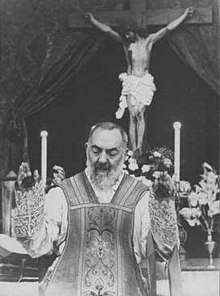
Pio was devoted to rosary meditations and said:[11]
"The person who meditates and turns his mind to God, who is the mirror of his soul, seeks to know his faults, tries to correct them, moderates his impulses, and puts his conscience in order."
He compared weekly confession to dusting a room weekly, and recommended the performance of meditation and self-examination twice daily: once in the morning, as preparation to face the day, and once again in the evening, as retrospection. His advice on the practical application of theology he often summed up in his now famous quote, "Pray, Hope and Don’t Worry". He directed Christians to recognize God in all things and to desire above all things to do the will of God.[12]
Many people who heard of him traveled to San Giovanni Rotondo to meet him and confess to him, ask for help, or have their curiosity satisfied. Pio's mother died at the village around the convent in 1928. Later, in 1938, Pio had his elderly father Grazio live with him. His brother Michele also moved in. Pio's father lived in a little house outside the convent, until his death in 1946.[13]
First World War and aftermath
When World War I started, four friars from this community were selected for military service in the Italian army. At that time, Padre Pio was a teacher at the seminary and a spiritual director. When one more friar was called into service, Pio was put in charge of the community. On 15 November 1915, he was drafted and on December 6, assigned to the 10th Medical Corps in Naples. Due to poor health, he was continually discharged and recalled until on 16 March 1918, he was declared unfit for service and discharged completely.[14]
People who had started rebuilding their lives after the war began to see in Padre Pio a symbol of hope.[12] Those close to him attest that he began to manifest several spiritual gifts, including the gifts of healing, bilocation, levitation, prophecy, miracles, extraordinary abstinence from both sleep and nourishment (one account states that Padre Agostino recorded one instance in which Padre Pio was able to subsist for at least 20 days at Verafeno on only communion wafers without any other nourishment), the ability to read hearts, the gift of tongues, the gift of conversions, and pleasant-smelling wounds.[15]
Padre Pio increasingly became well known among the wider populace. He became a spiritual director, and developed five rules for spiritual growth: weekly confession, daily Communion, spiritual reading, meditation, and examination of conscience.[12]
In August 1920, Pio led the blessing of a flag for a group of local veterans on the feast of the Assumption, and who were developing close links to local fascists.[16] Pio subsequently met with Giuseppe Caradonna, a fascist politician from Foggia, and became his confessor and that of members of his militia.[17][18] Luzzatto, suggests that Caradonna established a "praetorian guard" around Pio to protect him from removal by church authorities. An early biographer of Pio, Emanuele Brunatto, also mediated between Pio and the leaders of the growing Italian fascist movement.[19] Brunatto later donated his company that produced locomotives to Pio, which boosted the purchase of stocks by shareholders."[20] Brunatto's publisher, Giorgio Berlutti, had been an enthusiastic supporter of Mussolini's March on Rome, and used the biography to raise Pio's profile.[21] It has been suggested that "a clerical-fascist mixture developed around Padre Pio".[22] Pio also took a positive attitude towards Benito Mussolini.[23]
The hospital La Casa sollievo della sofferenza
By 1925 Pio had converted an old convent building into a medical clinic with a few beds intended primarily for people in extreme need.[24] In 1940, a committee was set-up to establish a bigger clinic [25] and donations started to be made. Construction began in 1947.[26]
According to Luzzatto, the bulk of the money for financing the hospital came directly from Brunatto (a keen follower of Pio but who had made his fortune in the black market in German occupied France).[27] The United Nations Relief and Rehabilitation Administration (UNRRA) also contributed funding - 250 million Italian lire.[28]
Lodovico Montini, head of Democrazia Cristiana and his brother Giovanni Battista Montini (later Pope Paul VI) facilitated engagement by UNRRA.[29] The hospital was initially to be named "Fiorello LaGuardia", but eventually presented as the work of Pio himself.[30][31] The "Casa sollievo della sofferenza" opened in 1956.[32] Pio handed direct control to the Holy See. However, in order that Pio might directly supervise the project, Pope Pius XII granted him a dispensation from his vow of poverty in 1957.[33][34] Some of Pio's detractors have subsequently suggested there had been misappropriation of funds.[33]
Investigations of Padre Pio by medical and church authorities
The Vatican initially imposed severe sanctions on Pio in the 1920s to reduce publicity about him: it forbade him from saying Mass in public, blessing people, answering letters, showing his stigmata publicly, and communicating with Padre Benedetto, his spiritual director.
The Church authorities decided that Pio be relocated to another convent in northern Italy.[35] The local people threatened to riot, and the Vatican left him where he was.[36] A second plan for removal was also changed.[36] Nevertheless, from 1921 to 1922 he was prevented from publicly performing his priestly duties, such as hearing confessions and saying Mass.[37] From 1924 to 1931, the Holy See made statements denying that the events in Pio's life were due to any divine cause.[12]
Amico Bignami, medical examination from 1919
The pathologist Amico Bignami conducted a medical examination of Father Pio's wounds in 1919 and concluded that it was a skin necrosis that was hindered from healing by chemicals such as iodine tincture.[38]
Giorgio Festa, medical examinations 1919 and 1920
Festa was a physician and examined Pio in 1919 and 1920. He was obviously impressed by the fragrance of the stigmata.[39] Festa, as Bignami before had described the side wound as cruciform.[40] In his report to the Holy Office of 1925, Festa worked out a benevolent verdict and attacked Gemelli's critical view of Pio's stigmata, with theological arguments playing the lead role.
Agostino Gemelli, psychiatric examination 1920 and medical examination 1925
A psychiatric examination was conducted by the psychiatrist, Franciscan priest Agostino Gemelli in 1920. He came to the conclusion that Francesco Forgione was a man of "restricted field of knowledge, low psychic energy, monotonous ideas, little volition." [41] Gemelli critically judged Pio: "The case is one of suggestion unconsciously planted by Father Benedetto in the weak mind of Padre Pio, producing those characteristic manifestations of psittacism that are intrinsic to the hysteric mind."[42]
On behalf of the Holy Office, Gemelli re-examined Father Pio in 1925, writing a report in April 1926. This time he let Pio show him the wounds. Gemelli saw as its cause the use of a corrosive substance. Pio had attached himself to these wounds. The Jesuit Festa had previously tried to question Gemelli's comments on stigmata in general.[43] Gemelli responded to this criticism in his report and resorted to responding to his knowledge of self-inflicted wounds. He therefore clarified his statements about the nature of Pio's wounds: "Anyone with experience in forensic medicine, and above all in variety by sores and wounds that self-destructive soldiers were presented during the war, can have no doubt that these were wounds of erosion caused by the use of a caustic substance. The base of the sore and its shape are in every way similar to the sores observed in soldiers who procured them with chemical means."[44]
Once again, Gemelli judged Father Pio's mental abilities as limited: "He [Pio] is the ideal partner with whom former Minister Provincial Father Benedetto is able to create an incubus-succubus pair ... He is a good priest: calm, quiet, meek, more because of the mental deficiency than out of virtue. A poor soul, able to repeat a few stereotypical religious phrases, a poor, sick man who has learned his lesson from his master, Father Benedetto."[45] Gemelli wrote in 1940 and later several times to the Holy Office on what he considers to be unjustified claims to the sanctity of Father Pio.[46]
Raffaele Rossi, First Apostolic Visitation of 1921
The Bishop of Volterra, Raffaele Rossi, Carmelite, was formally commissioned on June 11, 1921 by the Holy Office to make a canonical inquiry concerning Father Pio. Rossi began his Apostolic Visitation on June 14 in San Giovanni Rotondo with the interrogation of witnesses, two diocesan priests and seven friars. After eight days of investigation, he finally completed a benevolent report, which he sent to the Holy Office on October 4, 1921, the feast of St. Francis of Assisi. The extensive and detailed report essentially stated the following: Father Pio, of whom Rossi had a favorable impression, was a good religious and the San Giovanni Rotondo convent was a good community. Whatever is extraordinary about what Father Pio does that can not be explained, but certainly not by the intervention of the devil, or by deception or dizziness. Public exuberance has declined sharply.[47][48] During the interviews with the witnesses, which Rossi undertook a total of three times, he let himself be shown the stigmata of the then 34-year-old Father Pio. Rossi saw these stigmata as a “real fact”.[49]
In his notes, which have been put directly on paper, and the final report, Rossi describes the shape and appearance of the wounds. Those in the hands were "very visible". Those in the feet "were disappearing. What could be observed resembled two dot-shaped elevations [50] with whiter and gentler skin."[51] As for the page, it says: "At its side, the sign appears in the form of a triangular spot in the color of red wine and other, smaller patches, which at that time no longer take the shape of a .[52] Rossi also made a request to the Holy Office, a chronicle to consult with Father Pio, who is assembling Father Benedetto, or at least to have the material he has collected so that one day one can write about the life of Father Pio.[53]
According to Rossi, there was not even one "miracle". Especially, there was not any healing of sick people.[54] Lucia Ceci also writes that Rossi could not find any of the attributed miracles.[55]
When asked about bilocation, Pio stated that it did not exist ("not so far as I'm aware").[56]
John XXIII, investigations and tape recordings, after 1958
John XXIII was skeptical of Padre Pio. At the beginning of his tenure, he learned that Father Pio's opponents had placed listening devices in his monastery cell and confessional, recording his confessions with tape.[57] In a semi-official journal note, John XXIII wrote that he prayed for "PP" (Padre Pio). The tape recordings made it clear that he had "intimate and indecent relationships with women from his impenetrable praetorian guard around his person".[58] John XXIII had probably never listened to the tapes himself, but assumed the correctness of this view.[59] According to Luzzatto, the Vatican had not ordered this wiretap. In another journal note, John XXIII wrote that he wanted to take action. In fact, he ordered another Apostolic Visitation.[59]
Carlo Maccari, Second Apostolic Visitation of 1960
Father Carlo Maccari was Secretary-General of the Diocese of Rome and met Pio nine times altogether.[60] Pio was very suspicious of Maccari, who wrote in his diary: "Reticence, narrowness of mind, lies - these are the weapons he uses to evade my questions ... Overall impression: pitiful."[61] Maccari demanded Father Pio's omission to practice kisses after the confession for the lay sisters. In his report, Maccari noted that Pio had inadequate religious education. He works a lot for a man of his age. He is not an ascetic and has many connections to the outside world. In general, there is too much mixing of the "sacred" and the "all too human".[62] Maccari noted in his report by name, which woman stated at what time to have been the lover of Pio - without clearly assessing whether all these statements were true.[63] Maccari focused on assessing the fanaticism of Pio's social environment, describing it as "religious conceptions that oscillate between superstition and magic."[64] Maccari called Pio's supporters "a vast and dangerous organization."[65] Pio never had his own supporters advised to moderation. Maccari wondered how God could allow "so much deception."[66]
Maccari finished his critical report with a list of recommendations for further dealing with Father Pio. The brothers of Santa Maria delle Grazie should gradually be relocated, a new abbot should come from outside the region. No one should be allowed to confess to Pio more than once a month. The hospital was to be given new statutory statutes to sever the responsibilities of the medical and spiritual "healing" capuchins.[66] Following Maccari's Apostolic Visitation, John XXIII noted in his diary that he sees Father Pio as a "straw idol" (idolo di stoppa).[67]

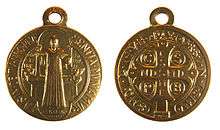
Alleged paranormal phenomena
Pio was said to have had the gift of reading souls, the ability to bilocate, among other supernatural phenomena. He was said to communicate with angels and worked favors and healings before they were requested of him.[69] The reports of supernatural phenomena surrounding Padre Pio attracted fame and legend. The Vatican was initially skeptical.
Stigmata
Based on Pio's correspondence, even early in his priesthood he experienced less obvious indications of the visible stigmata: bodily marks, pain, and bleeding in locations supposedly corresponding to the crucifixion wounds of Jesus Christ.[70] In a 1911 letter, he wrote to his spiritual advisor Padre Benedetto from San Marco in Lamis, describing something he had been apparently experiencing for a year:
Then last night something happened which I can neither explain nor understand. In the middle of the palms of my hands a red mark appeared, about the size of a penny, accompanied by acute pain in the middle of the red marks. The pain was more pronounced in the middle of the left hand, so much so that I can still feel it. Also under my feet I can feel some pain.[70]
Already in a letter dated March 21, 1912, to his spiritual companion and confessor, Father Agostino, Father Pio wrote of his devotion to the mystical body of Christ and the intuition that he, Pio, one day himself would bear the stigmata of Christ. Luzzatto points out that in this letter Father Pio uses unrecognized passages from a book by the stigmatized mystic Gemma Galgani. Later Pio denied knowing or owning the cited book.[71]
His close friend Padre Agostino wrote in 1915, asking specific questions, such as when he first experienced visions, whether he had been granted the stigmata, and whether he felt the pains of the Passion of Christ, namely the crowning of thorns and the scourging. Pio replied that he had been favoured with visions since his novitiate period (1903 to 1904). Although he had been granted the stigmata, he had been so terrified by the phenomenon he begged the Lord to withdraw them. He wrote that he did not wish the pain to be removed, only the visible wounds, since he considered them to be an indescribable and almost unbearable humiliation.[70]
On 20 September 1918, while hearing confessions, Pio claimed to have had a reappearance of the physical occurrence of the stigmata. The phenomenon was reported to have continued for fifty years, until the end of his life. The blood flowing from the stigmata purportedly smelled of perfume or flowers. He reported to Agostino that the pain remained and was more acute on specific days and under certain circumstances. He also said that he was suffering the pain of the crown of thorns and the scourging. He did not define the frequency of these occurrences but said that he had been suffering from them at least once weekly for some years.[70] Though Pio said he would have preferred to suffer in secret, by early 1919, news had begun to spread. Pio often wore red mittens or black coverings on his hands and feet as he was embarrassed by the marks.[33] However, no visible scarring was present at the time of Pio's death.[72]
In a letter to Padre Benedetto, his superior and spiritual advisor from San Marco in Lamis, dated 22 October 1918, Pio described his experience of receiving the stigmata:
On the morning of the 20th of last month, in the choir, after I had celebrated Mass I yielded to a drowsiness similar to a sweet sleep. [...] I saw before me a mysterious person similar to the one I had seen on the evening of 5 August. The only difference was that his hands and feet and side were dripping blood. This sight terrified me and what I felt at that moment is indescribable. I thought I should have died if the Lord had not intervened and strengthened my heart which was about to burst out of my chest. The vision disappeared and I became aware that my hands, feet and side were dripping blood. Imagine the agony I experienced and continue to experience almost every day. The heart wound bleeds continually, especially from Thursday evening until Saturday. Dear Father, I am dying of pain because of the wounds and the resulting embarrassment I feel deep in my soul. I am afraid I shall bleed to death if the Lord does not hear my heartfelt supplication to relieve me of this condition. Will Jesus, who is so good, grant me this grace? Will he at least free me from the embarrassment caused by these outward signs? I will raise my voice and will not stop imploring him until in his mercy he takes away, not the wound or the pain, which is impossible since I wish to be inebriated with pain, but these outward signs which cause me such embarrassment and unbearable humiliation[74]....the pain was so intense that I began to feel as if I were dying on the cross.[75]
Once made public, the wounds were studied by a number of physicians, some hired by the Vatican as part of an independent investigation. Some claimed that the wounds were unexplainable and never seem to have become infected.[33][76] Despite seeming to heal they would then reappear periodically.[77] Alberto Caserta took X-rays of Pio's hands in 1954 and found no abnormality in the bone structure.[78] Many critics (both contemporary and posthumous) accused Pio of faking the stigmata, for example by using carbolic acid to make the wounds. Maria De Vito (the cousin of a local pharmacist at Foggia) testified that the young Pio bought four grams of carbolic acid in 1919:
"I was an admirer of Padre Pio and I met him for the first time on July 31, 1919...he gave me personally an empty bottle, and asked if I would act as a chauffeur to transport it back from Foggia to San Giovanni Rotondo with four grams of pure carbolic acid. ... He explained that the acid was for disinfecting syringes for injections. He also asked for other things, such as Valda pastilles."[79]
In contrast, a number of Catholic clerics have dismissed charges that carbolic acid was used to fake the stigmata: "The boys had needed injections to fight the Spanish Flu which was raging at that time. Due to a shortage of doctors, Padres Paolino and Pio administered the shots, using carbolic acid as a sterilizing agent.”[79][80][81]
Healing
In the 1999 book, Padre Pio: The Wonder Worker, a segment by Irish priest Malachy Gerard Carroll describes the story of Gemma de Giorgi, a Sicilian girl whose blindness was believed to have been cured during a visit to Padre Pio.[82] Gemma, who was brought to San Giovanni Rotondo in 1947 by her grandmother, was born without pupils. During her trip to see Padre Pio, the little girl began to see objects, including a steamboat and the sea.[82][83] Gemma's grandmother did not believe the child had been healed. After Gemma forgot to ask Padre Pio for grace during her confession, her grandmother implored the priest to ask God to restore her sight.[82] Padre Pio told her, "The child must not weep and neither must you for the child sees and you know she sees."[82]
Apparitions
During his period of spiritual suffering, his followers believe that Padre Pio was attacked by the devil, both physically and spiritually.[15] His followers also believe that the devil used diabolical tricks in order to increase Padre Pio's torments. These included apparitions as an "angel of light" and the alteration or destruction of letters to and from his spiritual directors. Padre Augustine confirmed this when he said:
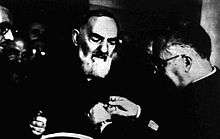
Now, twenty-two days have passed since Jesus allowed the devils to vent their anger on me. My Father, my whole body is bruised from the beatings that I have received to the present time by our enemies. Several times, they have even torn off my shirt so that they could strike my exposed flesh.[84]
Padre Pio reported engaging in physical combat with Satan and his minions, similar to incidents described concerning St. John Vianney, from which he was said to have sustained extensive bruising.
On the day of Padre Pio's death, mystic and Servant of God Maria Esperanza de Bianchini from Venezuela reported that he appeared to her in a vision and said, "I have come to say good-bye. My time has come. It is your turn."[85][86][87] Her husband saw his wife's face transfigured into that of Padre Pio.[86] On the following day, they learned that Padre Pio had died.[85][87] Witnesses say they later saw Esperanza levitating during Mass and engaging in bilocation.[87] Padre Domenico da Cese, a fellow Capuchin stigmatist, reported that on 22 September 1968, he saw Padre Pio kneeling in prayer before the Holy Face of Manoppello, although it was known that Padre Pio had not left his room.[88]
Transverberation
| Part of a series on | |||||||||||||||||||||||||||||
| Christian mysticism | |||||||||||||||||||||||||||||
|---|---|---|---|---|---|---|---|---|---|---|---|---|---|---|---|---|---|---|---|---|---|---|---|---|---|---|---|---|---|
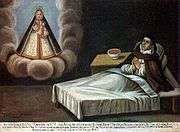 | |||||||||||||||||||||||||||||
|
Theology · Philosophy
|
|||||||||||||||||||||||||||||
|
Practices
|
|||||||||||||||||||||||||||||
|
People (by era or century)
|
|||||||||||||||||||||||||||||
|
Literature · Media
|
|||||||||||||||||||||||||||||
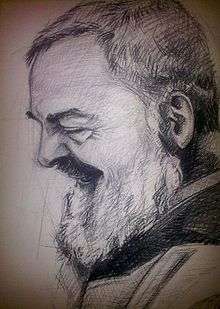
World War I continued and in July 1918, Pope Benedict XV, who had termed the World War "the suicide of Europe," appealed to all Christians urging them to pray for an end to the World War. On 27 July of the same year, Padre Pio offered himself as a victim for the end of the war. Days passed and between 5 and 7 August, Padre Pio had a vision in which Christ appeared and pierced his side.[4][12]
As a result, Padre Pio claimed to have received a physical wound in his side. This occurrence is considered as a transverberation or "piercing of the heart", indicating the union of love with God within Christian mysticism.



The occasion of transverberation coincided with a seven-week-long period of spiritual unrest for Padre Pio. One of his Capuchin brothers said this of his state during that period:
During this time his entire appearance looked altered as if he had died. He was constantly weeping and sighing, saying that God had forsaken him.[4]
In a letter from Padre Pio to Padre Benedetto, dated 21 August 1918, Padre Pio writes of his experiences during the transverberation:
While I was hearing the boys’ confessions on the evening of the 5th [August] I was suddenly terrorized by the sight of a celestial person who presented himself to my mind’s eye. He had in his hand a sort of weapon like a very long sharp-pointed steel blade which seemed to emit fire. At the very instant that I saw all this, I saw that person hurl the weapon into my soul with all his might. I cried out with difficulty and felt I was dying. I asked the boy to leave because I felt ill and no longer had the strength to continue. This agony lasted uninterruptedly until the morning of the 7th. I cannot tell you how much I suffered during this period of anguish. Even my entrails were torn and ruptured by the weapon, and nothing was spared. From that day on I have been mortally wounded. I feel in the depths of my soul a wound that is always open and which causes me continual agony.[74]
On 20 September 1918, accounts state that the pains of the transverberation had ceased and Pio was in "profound peace."[4] On that day, as he was engaged in prayer in the choir loft in the Church of Our Lady of Grace, he received another celestial vision which led to religious ecstasy. When the ecstasy ended, Pio claimed to have received the visible stigmata, the five wounds of Christ. This time, the stigmata were permanent. They stayed visible for the next fifty years of his life.[12]
Prophecy
In 1947, Father Karol Józef Wojtyła (later Pope John Paul II) visited Padre Pio, who heard his confession. Austrian Cardinal Alfons Stickler reported that Wojtyła confided to him that during this meeting, Padre Pio told him he would one day ascend to "the highest post in the church though further confirmation is needed."[89] Stickler said that Wojtyła believed that the prophecy was fulfilled when he became a cardinal.[90] John Paul's secretary, Stanisław Dziwisz, denies the prediction,[91] while George Weigel's biography Witness to Hope, which contains an account of the same visit, does not mention it.
According to tradition,[92] Bishop Wojtyła wrote to Padre Pio in 1962 to ask him to pray for Wanda Poltawska, a friend in Poland who was suffering from cancer. Later, Poltawska's cancer was apparently found to be in spontaneous remission. Medical professionals were seemingly unable to offer an explanation for the phenomenon.[93]
Rehabilitation
By 1933, the tide began to turn. Pope Pius XI ordered a reversal of the ban on Padre Pio's public celebration of Mass, arguing, "I have not been badly disposed toward Padre Pio, but I have been badly informed."[12] In 1934, the friar was again allowed to hear confessions. He was also given honorary permission to preach despite never having taken the exam for the preaching license. Pope Pius XII, who assumed the papacy in 1939, even encouraged devotees to visit Padre Pio.
Finally, in the mid-1960s Pope Paul VI (pope from 1963 to 1978) dismissed all accusations against Padre Pio.[33][94][95]
Death
Pio died in 1968 at the age of 81. His health deteriorated in the 1960s but he continued his spiritual works. On 21 September 1968, the day after the 50th anniversary of his receiving the stigmata, Padre Pio felt great fatigue.[96] The next day, on September 22, 1968, he was supposed to offer a Solemn Mass, but feeling weak, he asked his superior if he might say a Low Mass instead, as he had done daily for years. Due to the large number of pilgrims present for the Mass, Padre Pio's superior decided the Solemn Mass must proceed. Padre Pio carried out his duties but appeared extremely weak and fragile. His voice was weak and, after the Mass had concluded, he nearly collapsed while walking down the altar steps. He needed help from his Capuchin brothers. This was his last celebration of the Mass.
Early in the morning of 23 September 1968, Pio made his last confession and renewed his Franciscan vows.[12] As was customary, he had his rosary in his hands, though he did not have the strength to say the Hail Marys aloud. Till the end, he repeated the words "Gesù, Maria" (Jesus, Mary). At around 2:30 a.m., he said, "I see two mothers" (taken to mean his mother and Mary).[96] At 2:30 a.m. he died in his cell in San Giovanni Rotondo. With his last breath he whispered, "Maria!"[3]
His body was buried on 26 September in a crypt in the Church of Our Lady of Grace. His Requiem Mass was attended by over 100,000 people. He had often said, "After my death I will do more. My real mission will begin after my death."[96] The accounts of those who stayed with Padre Pio till the end state that the stigmata had completely disappeared without a scar. Only a red mark "as if drawn by a red pencil" remained on his side but it disappeared.[96]
Posthumous veneration

In 1971, three years after his death, Pope Paul VI said to the superiors of the Capuchin Order about Pio:
Look what fame he had, what a worldwide following gathered around him! But why? Perhaps because he was a philosopher? Because he was wise? Because he had resources at his disposal? Because he said Mass humbly, heard confessions from dawn to dusk and was–it is not easy to say it–one who bore the wounds of our Lord. He was a man of prayer and suffering.[97]
In 1982, the Holy See authorized the archbishop of Manfredonia to open an investigation to determine whether Pio should be canonized. The investigation continued for seven years. In 1990 Pio was declared a Servant of God, the first step in the process of canonization. The investigation, however, did not lead to any public factual clearance by the Church on his previous 'excommunication' or on the allegations that his stigmata were not of a supernatural kind. Moreover, Pio's stigmata were remarkably left out of the obligatory investigations for the canonization process, in order to avoid obstacles prohibiting a successful closure.
Beginning in 1990, the Congregation for the Causes of Saints debated how Padre Pio had lived his life, and in 1997 Pope John Paul II declared him venerable. A discussion of the effects of his life on others followed. Cases were studied such as a reported cure of an Italian woman, Consiglia de Martino, associated with Padre Pio's intercession. In 1999, on the advice of the Congregation, John Paul II declared Padre Pio blessed. A media offensive by the Capuchins was able to realise a broad acceptation of the contested saint in society.[98]
After further consideration of Padre Pio's virtues and ability to do good even after his death, including discussion of another healing attributed to his intercession, John Paul II declared Padre Pio a saint on 16 June 2002.[90] An estimated 300,000 people attended the canonization ceremony in Rome.[90]
On 1 July 2004, John Paul II dedicated the Sanctuary of Saint Pio of Pietrelcina (sometimes referred as Padre Pio Pilgrimage Church), built in the village of San Giovanni Rotondo to the memory of Saint Pio of Pietrelcina.[99]
On 3 March 2008, the body of Pio was exhumed from his crypt, forty years after his death, so that his remains could be prepared for display. A church statement described the body as being in "fair condition". Archbishop Domenico Umberto D'Ambrosio, Papal legate to the shrine in San Giovanni Rotondo, stated "the top part of the skull is partly skeletal but the chin is perfect and the rest of the body is well preserved".[100] Archbishop D’Ambrosio also confirmed in a communiqué that “the stigmata are not visible.”[101] He said that Pio's hands "looked like they had just undergone a manicure". It was hoped that morticians would be able to restore the face so that it will be recognizable. However, because of its deterioration, his face was covered with a lifelike silicone mask.[102]
Cardinal José Saraiva Martins, prefect for the Congregation for the Causes of the Saints, celebrated Mass for 15,000 devotees on April 24 at the Shrine of Holy Mary of Grace, San Giovanni Rotondo, before the body went on display in a crystal, marble, and silver sepulcher in the crypt of the monastery.[103] Padre Pio is wearing his brown Capuchin habit with a white silk stole embroidered with crystals and gold thread. His hands hold a large wooden cross. 800,000 pilgrims worldwide, mostly from Italy, made reservations to view the body up to December 2008, but only 7,200 people a day were able to file past the crystal coffin.[104][105][106] Officials extended the display through September, 2009.[107]
Pio's remains were placed in the church of Saint Pio, which is beside San Giovanni Rotondo. In April 2010 they were moved to a special golden "Cripta".[108]
A statue of Pio in Messina, Sicily attracted attention in 2002 when it supposedly wept tears of blood.[109]
Saint Pio of Pietrelcina is known as the patron saint of civil defence volunteers, after a group of 160 petitioned the Italian Bishops’ conference for this designation. The bishops forwarded the request to the Vatican, which gave its approval to the designation.[110] He is also “less officially” known as the patron saint of stress relief and the “January blues,” after the Catholic Enquiry Office in London proclaimed him as such. They designated the most depressing day of the year, identified as January 22, as Don't Worry Be Happy Day, in honor of Padre Pio's famous advice: “Pray, hope, and don’t worry.”[111]
Padre Pio has become one of the world's most popular saints.[112] There are more than 3,000 "Padre Pio Prayer Groups" worldwide, with three million members. The first St Padre Pio parish http://www.stpp.church/home.html in the world was established 16 June 2002 in Kleinburg, Ontario, Canada. There are parishes in Vineland and Lavallette, New Jersey, and Sydney, Australia, and shrines in Buena, New Jersey, and Santo Tomas, Batangas, Philippines, dedicated to Padre Pio. A 2006 survey by the magazine Famiglia Cristiana found that more Italian Catholics pray to Padre Pio for intercession than to any other figure.[113]
It was announced in 2009 that a renewable energy statue of Padre Pio was to be built on a hill near the town of San Giovanni Rotondo in the south-eastern province of Apulia, Italy, the town where he is commemorated. The project would cost several million pounds, with the money to be raised from the saint's devotees around the world. The statue would be coated in a special photovoltaic paint, enabling it to trap the sun's heat and produce solar energy, making it an "ecological" religious icon.[114]
.jpg)
.jpg)
The remains of Saint Pio were brought to the Vatican for veneration during the 2015–2016 Extraordinary Jubilee of Mercy. Saint Pio and Saint Leopold Mandic were designated as saint-confessors to inspire people to become reconciled to the Church and to God, by the confession of their sins.[115]
- Sculptures and altars of Padre Pio throughout the world
- A sculpture of Padre Pio in Serra Pedace
 A sculpture of Padre Pio in a garden in Naples
A sculpture of Padre Pio in a garden in Naples_-_nave%2C_altar_to_St._Padre_Pio_of_Pietrelcina.jpg)
%2C_interior%2C_Padre_Pio_shrine.jpg) A sculpture of Padre Pio in Carey, Ohio
A sculpture of Padre Pio in Carey, Ohio- A sculpture of Padre Pio in Rome
 Padre Pio statue
Padre Pio statue A sculpture of Padre Pio helping Christ to bear the cross in the San Salvatore in Lauro church in Rome
A sculpture of Padre Pio helping Christ to bear the cross in the San Salvatore in Lauro church in Rome.jpg) A sculpture of Padre Pio in Taormina, Sicily
A sculpture of Padre Pio in Taormina, Sicily
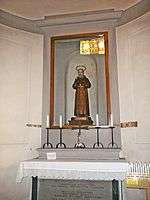 Statue in a church in Barberino di Mugello, Florence, Italy
Statue in a church in Barberino di Mugello, Florence, Italy Padre Pio statue at a house in Porto Azzurro
Padre Pio statue at a house in Porto Azzurro Sculpture of Pio of Pietrelcina in Villa di Galceto in the province of Prato
Sculpture of Pio of Pietrelcina in Villa di Galceto in the province of Prato
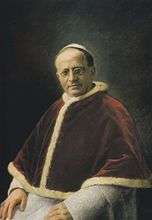 Pope Pius XI began the end of the restrictions against Padre Pio of Pietrelcina around 1933.
Pope Pius XI began the end of the restrictions against Padre Pio of Pietrelcina around 1933. Pope Pius XII, pope from 1939, encouraged devotees to visit Padre Pio of Pietrelcina.
Pope Pius XII, pope from 1939, encouraged devotees to visit Padre Pio of Pietrelcina..jpg) Pope John XXIII, pope from 1958, was deeply sceptical of Padre Pio and suspected him of being a fraud.
Pope John XXIII, pope from 1958, was deeply sceptical of Padre Pio and suspected him of being a fraud.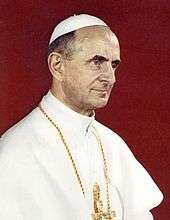 Pope Paul VI, in the mid-1960s, firmly dismissed all accusations against Padre Pio of Pietrelcina.
Pope Paul VI, in the mid-1960s, firmly dismissed all accusations against Padre Pio of Pietrelcina. Pope John Paul II beatified (1999) and canonized (2002) Padre Pio of Pietrelcina.
Pope John Paul II beatified (1999) and canonized (2002) Padre Pio of Pietrelcina.
See also
- Padre Pio TV
- Sanctuary of Saint Pio of Pietrelcina
- Carmela Carabelli
- Incorruptibility
- Victim soul
- Visions of Jesus and Mary
- Weeping statue
References
- "BBC – Religions – Christianity: Saint Pio of Pietrelcina". Retrieved 2017-11-23.
- ""Padre Pio de Pietrelcina",- PADRE PIO DA PIETRELCINA". Vatican News Service.
- Ruffin, Bernard C. (1991). Padre Pio: The True Story. Our Sunday Visitor. pp. 444. ISBN 978-0-87973-673-6.
- Gerhold, Ryan (2007-02-20). "The Second St. Francis". The Angelus: 12–18.
- "Padre Pio the Man Part 1". Retrieved 2008-01-19.
- "Saints". The American Catholic.
- Convento Pietralcina. "La chiesetta di Sant'Anna". cappuccinipietrelcina.com. Archived from the original on 5 August 2014. Retrieved 30 July 2014.
- Renzo Allegri, I miracoli di Padre Pio p. 21.
- "Padre Pio da Pietrelcina", Vatican News Service
- Charles Mortimer Carty, Rev. Fr (September 1994). Padre Pio: The Stigmatist. ISBN 9781618902634.
- The Rosary: A Path Into Prayer by Liz Kelly 2004 ISBN 0-8294-2024-X pp. 79, 86
- "Padre Pio the Man Part 2". Retrieved 2008-01-19.
- Ylva-Kristina Sjöblom. Padre Pio. Catholica. pp. 10, 85.
- "Chronology". Padre Pio Devotions.
- Pelletier, Joseph A. "Padre Pio, Mary, and the Rosary". Garabandal. Retrieved 2008-01-19.
- Sergio Luzzatto (2011): Padre Pio: Miracles and Politics in a Secular Age, p. 68.
- Sergio Luzzatto (2011): Padre Pio: Miracles and Politics in a Secular Age, p. 85.
- Sergio Luzzatto (2011): Padre Pio: Miracles and Politics in a Secular Age, p. 89.
- Sergio Luzzatto (2011): Padre Pio: Miracles and Politics in a Secular Age, p. 148
- Sergio Luzzatto (2011): Padre Pio: Miracles and Politics in a Secular Age, p. 192.
- Sergio Luzzatto (2011): Padre Pio: Miracles and Politics in a Secular Age, p. 149
- Julius Müller-Meiningen: Padre Pio - Holy charlatan '"But while Italy argues about Padre Pio and the acid, Luzzatto’s really important theses are about something different: For example, the pious Father openly supported the reviving fascist movement around 1920 and at that time a clerical-fascist mixture around Padre Pio arose."Süddeutsche Zeitung, May 19, 2010.
- Urte Krass: Urte Krass: Kontrollierter Gesichtsverlust. Padre Pio und die Fotografie. (Controlled loss of face. Padre Pio and the photograph.) In: Zeitschrift für Ideengeschichte, Heft IV/2 (2010), S. 71–96 (Paraphrase zu S. 74) https://www.z-i-g.de/pdf/ZIG_2_2010_krass.pdf
- https://en.catholicnewsagency.com/story/the-cabinet- on-the-hill-the-earth-work-of-pater-pio-3452
- Francesco Castelli, Padre Pio Under Investigation - The Secret Vatican Files, Ignatius Press, 2011, p. 293
- https://en.catholicnewsagency.com/story/the-hospital-on-the-hugel-that-worldly-work-of-pater-pio-3452
- Sergio Luzzatto (2011): Padre Pio: Miracles and Politics in a Secular Age 205 and 219.
- Sergio Luzzatto (2011): Padre Pio: Miracles and Politics in a Secular Age, p. 219 ff.
- Sergio Luzzatto (2011): Padre Pio: Miracles and Politics in a Secular Age, p. 221 f.
- Sergio Luzzatto (2011): Padre Pio: Miracles and Politics in a Secular Age, p. 228.
- Sergio Luzzatto (2011): Padre Pio: Miracles and Politics in a Secular Age, p. 225 ff.
- Francesco Castelli, Padre Pio Under Investigation - The Secret Vatican Files, Ignatius Press, 2011, p. 293
- "Catholics: A Padre's Patience". Time. April 24, 1964. Retrieved 7 April 2011.
- Marie osb, Dom Antoine (2000-04-24). "Letter on Blessed Pader Pio: Stigmata – Sacraments of Penance and Eucharist – Suffering". Retrieved 2006-09-27.
- "Close encounters with Padre Pio". PadrePio. Retrieved 2014-05-04.
- Allen, John L. (December 28, 2001). "For all who feel put upon by the Vatican: A new patron saint of Holy Rehabilitation". National Catholic Reporter. 1 (18). Retrieved 2008-01-19.
- "Religion: The Stigmatist". Time. December 19, 1949. Retrieved 7 April 2011.
- Sergio Luzzatto (ref. 2011): Padre Pio: Miracles and Politics in a Secular Age. P. 39.
- Sergio Luzzatto (2011): Padre Pio: Miracles and Politics in a Secular Age, p. 139
- Francesco Castelli, Padre Pio Under Investigation - The Secret Vatican Files , Ignatius Press, 2011 p. 20, pp. 44, 49ff.
- Sergio Luzzatto (2011): Padre Pio: Miracles and Politics in a Secular Age. P. 59.
- " "Sergio Luzzatto (2011) Padre Pio: Miracles and Politics in a Secular Age. P. 59.
- Sergio Luzzatto (2011): Padre Pio: Miracles and Politics in a Secular Age, p. 140.
- In: Sergio Luzzatto (2011): Padre Pio: Miracles and Politics in a Secular Age, p. 140.
- Sergio Luzzatto (2011): Padre Pio: Miracles and Politics in a Secular Age, p. 141.
- Sergio Luzzatto (2011): Padre Pio: Miracles and Politics in Secular Age, p. 259.
- Francesco Castelli, Padre Pio Under Investigation - The secret Vatican files , Ignatius Press, 2011, p. 20, p. 28, p. 67
- https://www.catholicnewsagency.com/news/details_of_first_investigation_into_padre_pios_stigmata_revealed
- Francesco Castelli, Padre Pio Under Investigation - The Secret Vatican Files, Ignatius Press, 2011, p. 21
- literally: 'buttons'
- Francesco Castelli, Padre Pio Under Investigation - The secret Vatican files , Ignatius Press , 2011, p. 21
- Francesco Castelli, Padre Pio Under Investigation - The secret Vatican files , Ignatius Press, 2011, p. 22f.
- Padre Pio Under Investigation - The secret Vatican files , Ignatius Press, 2011, P. 28
- Francesco Castelli, Padre Pio Under Investigation - The secret Vatican files , Ignatius Press, 2011 p. 20, pp. 100ff., p. 139ff.
- Lucia Ceci: The Vatican and Mussolini's Italy, Brill, 2016, , p. 114.
- Sergio Luzzatto (2011): Padre Pio: Miracles and Politics in a Secular Age, p. 102.
- Sergio Luzzatto (2011): Padre Pio: Miracles and Politics in a Secular Age , P. 270.
- Sergio Luzzatto (2011): Padre Pio: Miracles and Politics in a Secular Age, p. 270.
- Sergio Luzzatto (2011): Padre Pio: Miracles and Politics in a Secular Age, p. 271.
- Sergio Luzzatto (2011): Padre Pio: Miracles and Politics in a Secular Age, p. 272.
- Sergio Luzzatto (2011): Padre Pio: Miracles and Politics in a Secular Age, p. 273.
- Sergio Luzzatto (2011): Padre Pio: Miracles and Politics in a Secular Age, p. 274.
- Sergio Luzzatto (2011): Padre Pio: Miracles and Politics in a Secular Age , p. 274.
- Sergio Luzzatto (2011): Padre Pio: Miracles and Politics in a Secular Age, p. 275.
- Sergio Luzzatto (2011): Padre Pio: Miracles and Politics in a Secular Age , p. 276.
- Sergio Luzzatto (2011): Padre Pio: Miracles and Politics in a Secular Age, p. 277.
- Sergio Luzzatto (2011): Padre Pio: Miracles and Politics in a Secular Age, p. 278.
- Ylva-Christina Sjöblom (2003). Padre Pio. Catholica. ISBN 978-91-86428-84-6.
- Carroll-Cruz, Joan (March 1997). Mysteries Marvels and Miracles In the Lives of the Saints. Illinois: TAN Books. p. 581. ISBN 978-0-89555-541-0.
- McGregor, O.C.S.O, Augustine; Fr. Alessio Parente, O.F.M. Cap. (1974). The Spirituality of Padre Pio. San Giovanni Rotondo, FG, Italy: Our Lady of Grace Monastery. Retrieved 2015-01-16.
- Sergio Luzzatto (2011): Padre Pio: Miracles and Politics in a Secular Age, p. 19.
- "Padre Pio's Cell". Padre Pio Foundation. 2006-05-12. Retrieved 2006-05-12.
- Complete illustration of the photograph by Urte Krass: Kontrollierter Gesichtsverlust. Padre Pio und die Fotografie.(Engl.: Controlled loss of face. Padre Pio and the Photography.’’) In: Zeitschrift für Ideengeschichte, Heft IV/2, 2010, p. 74, where Krass shows the "staged character" of this photograph and places it in an art-historical context.
- "First class relic of St. Padre Pio of Pietrelcina at St. John Cantius Church". Retrieved 2008-01-19.
- Fortin, Fr. Michael. Padre Pio, A Priest. The Angelus Online
- Michael Freze (1989). They Bore the Wounds of Christ: The Mystery of the Sacred Stigmata. OSV Publishing. pp. 283–285. ISBN 978-0-87973-422-0.
- Padre Pio
- Ruffin, Bernard. Padre Pio: The True Story; 1991 OSV Press ISBN 0-87973-673-9 pages 160–163
- Moore, Malcolm (2007-10-24). "Italy's Padre Pio 'faked his stigmata with acid'". The Daily Telegraph. Rome. Retrieved 2012-04-25.
- Rega (2005), p. 55
- Schiffman, Richard (2011-11-28). "Did Padre Pio Fake His Stigmata Wounds?". Huffington Post.
- Kalvelage, Bro. Francis Mary (1999). Padre Pio: The Wonder Worker. Ignatius Press. p. 210. ISBN 978-0-89870-770-0.
- "THE HEALING OF GEMMA DI GIORGI". Archived from the original on 2009-06-08. Retrieved 2016-06-13.
- "Padre Pio da Pietrelcina Epistolario I° (1910–1922)". Retrieved 2008-01-19.
- Brooks, Stevern, Where are the Mantles, pp. 49–51, Xulon Books
- Brown, Michael The Incredible Story Of Maria Esperanza Spirit Daily
- Davidson, Linda Kay and David Martin Gitlitz, Pilgrimage: from the Ganges to Graceland : an encyclopedia, Volume 1, p. 59, ABC-CLIO 2002
- The Face of God, Paul Badde, p. 231.
- Kwitny, Jonathan (March 1997). Man of the Century: The Life and Times of Pope John Paul II. New York: Henry Holt and Company. pp. 768. ISBN 978-0-8050-2688-7.
- Zahn, Paula (2002-06-17). "Padre Pio Granted Sainthood". CNN. Retrieved 2008-01-19.
- Dziwisz, Stanisław (2008). A Life with Karol: My Forty-Year Friendship with the Man Who Became Pope. Doubleday. ISBN 978-0-385-52374-5.
- "The Word From Rome". nationalcatholicreporter.org.
- Rega, Frank M. (2005). Padre Pio and America. TAN Books. p. 308. ISBN 978-0-89555-820-6.
- Allen, John L. (December 28, 2001). "For all who feel put upon by the Vatican: A new patron saint of Holy Rehabilitation". National Catholic Reporter. 1 (18). Retrieved 2008-01-19.
- "Fifty years ago Italy's most famous modern saint was being treated like a criminal". Catholic Herald. 12 June 2014. Retrieved 15 June 2019.
- Schug, Rev. John (1987). A Padre Pio Profile. Huntington. ISBN 978-0-87973-856-3.
- "By Cardinal O'Malley OFM Cap. Prayer, etc". Archdiocese of Boston. Retrieved 11 April 2014.
- Peter Jan Margry, 'Il "marketing" di Padre Pio. Strategie cappuccine e Vaticane e la coscienza religiosa collettiva', in: Sanctorum. Revista dell'associazione Italiana per lo studio della santità, dei culti e dell'agiografia 5 (2008) pp. 141–167.
- Hooper, John (2004-07-02). "Guardian Unlimited Arts". Monumental church dedicated to controversial saint Padre Pio. London. Retrieved 2006-05-12.
- "Italy exhumes revered monk's body". BBC Online. 3 March 2008. Retrieved 16 March 2008.
- "St. Padre Pio's Body Exhumed". Zenit. Archived from the original on 2008-04-28. Retrieved 2008-03-06.
- Moore, Malcolm. "Padre Pio pilgrims flock to see saint's body" Telegraph. 25 April 2008
- "Faithful to be able to venerate exhumed remains of Padre Pio". Catholic News Agency.
- iht.com, Faithful await display of Catholic mystic's body
- "Thousands in Italy flock to see exhumed saint Padre Pio". Stars and Stripes.
- heraldextra.com, Mystic monk is exhumed second time Archived 2008-04-26 at the Wayback Machine
- www.theaustralian.news.com.au, Corpse of mystic monk moves the crowd
- Article (in Italian) with photos of Padre Pio golden Cripta
- "Italian statue weeps blood". BBC News. 2002-03-06. Retrieved 2006-05-12.
- "Italy makes St. Padre Pio patron of civil defense volunteers". The Georgia Bulletin. 2004-03-30. Archived from the original on 2004-09-11. Retrieved 2010-08-20.
- "Saint Pio of Pietrelcina". BBC Religions. 2009-07-31. Retrieved 2010-08-20.
- Peter Jan Margry, 'Merchandising and Sanctity: the invasive cult of Padre Pio', in: Journal of Modern Italian Studies 7 (2002) pp. 88–115
- "Exhumed body of Italian saint draws thousands". Reuters. 24 April 2006.
- Squires, Nick (2009-08-05). "Italy to build solar-energy-producing statue of saint". The Daily Telegraph. London. Retrieved 2010-05-22.
- "Archived copy". Archived from the original on 2015-10-04. Retrieved 2015-10-03.CS1 maint: archived copy as title (link)
External links
| Wikiquote has quotations related to: Padre Pio |
| Wikimedia Commons has media related to Padre Pio. |
- "Padre Pio de Pietrelcina" in Vatican News Service
- Padre Pio of Pietrelcina – Official website (in Italian and English)
- Magazine "The Voice of Padre Pio" – Official website (in English)
- Sanctuary of Saint Pio of Pietrelcina – Official Website (in Italian and English)
- Padre Pio of Pietrelcina – Official TV and radio channels (in Italian and English)
- Padre Pio of Pietrelcina – Books and religious gifts (in Italian and English)
- Padre Pio Foundation of America
- Padre Pio 2000 Movie
- Prayers by Padre Pio
- All about Padre Pio
Unofficial biographies
- The New York Times, April 25, 2008: "Italian Saint Stirs Up a Mix of Faith and Commerce".
- Catholic television network EWTN biography.

_10.jpg)